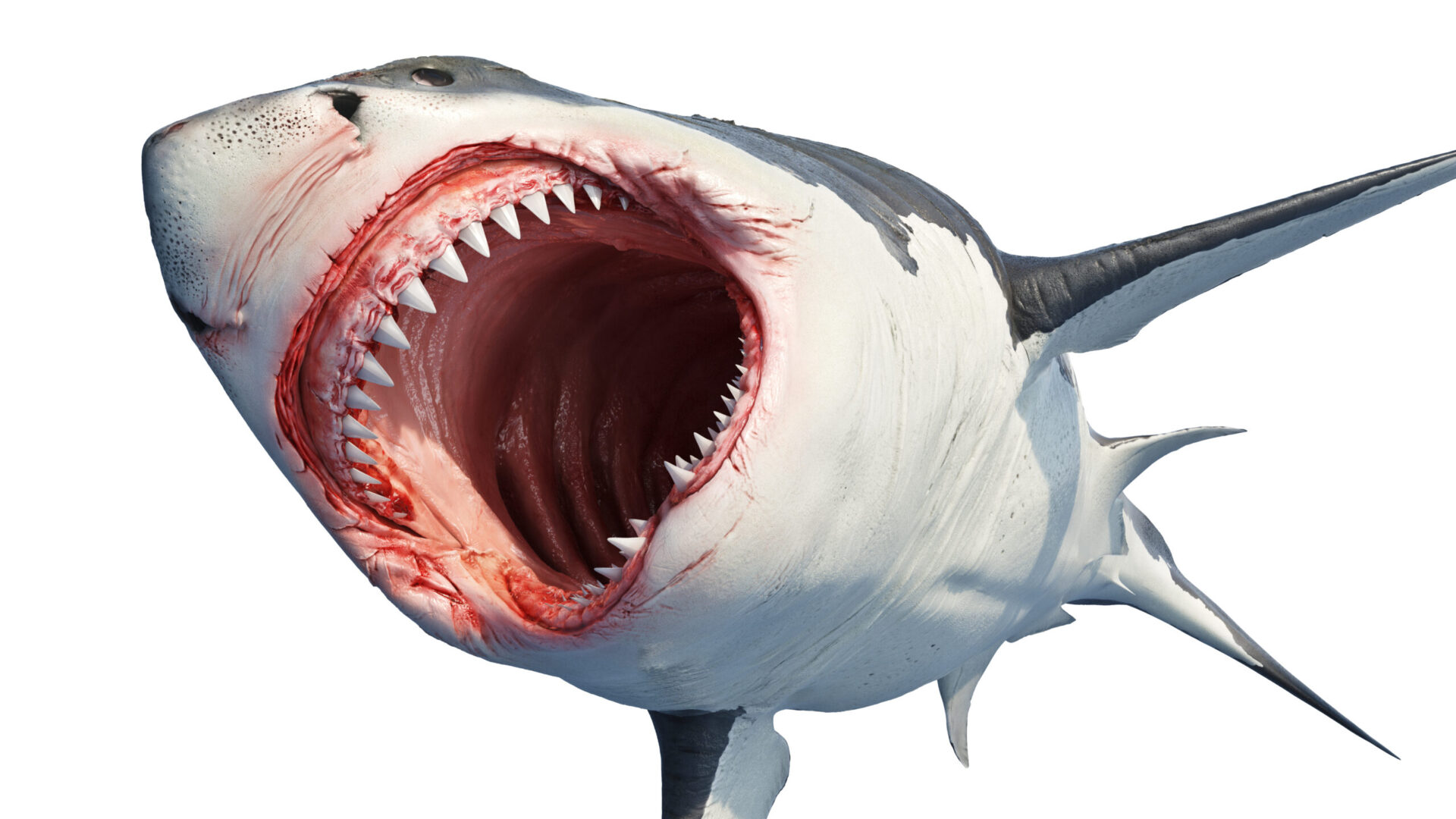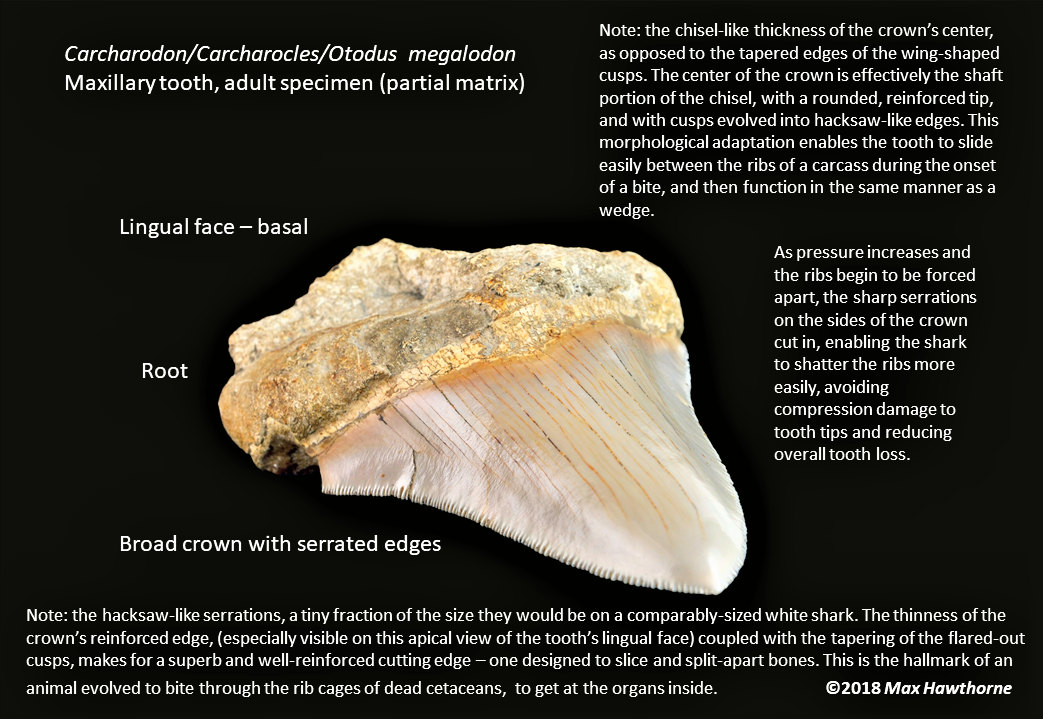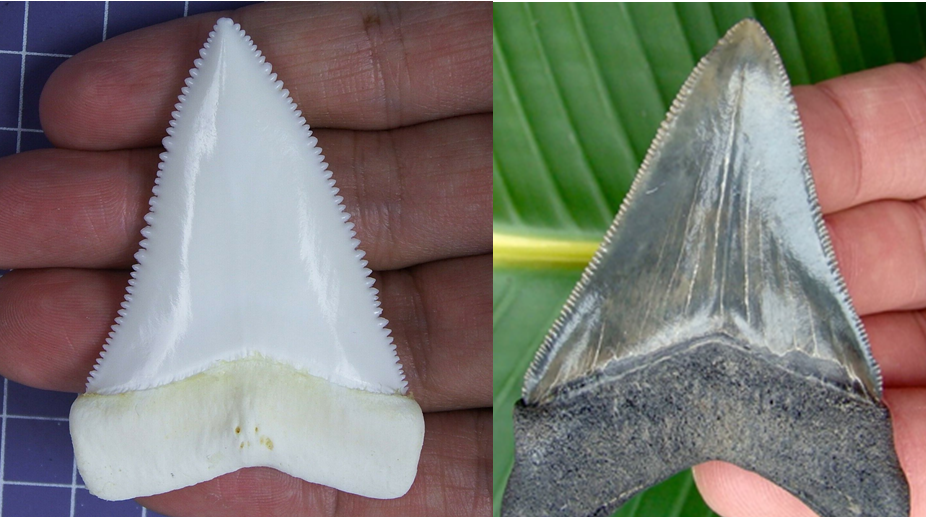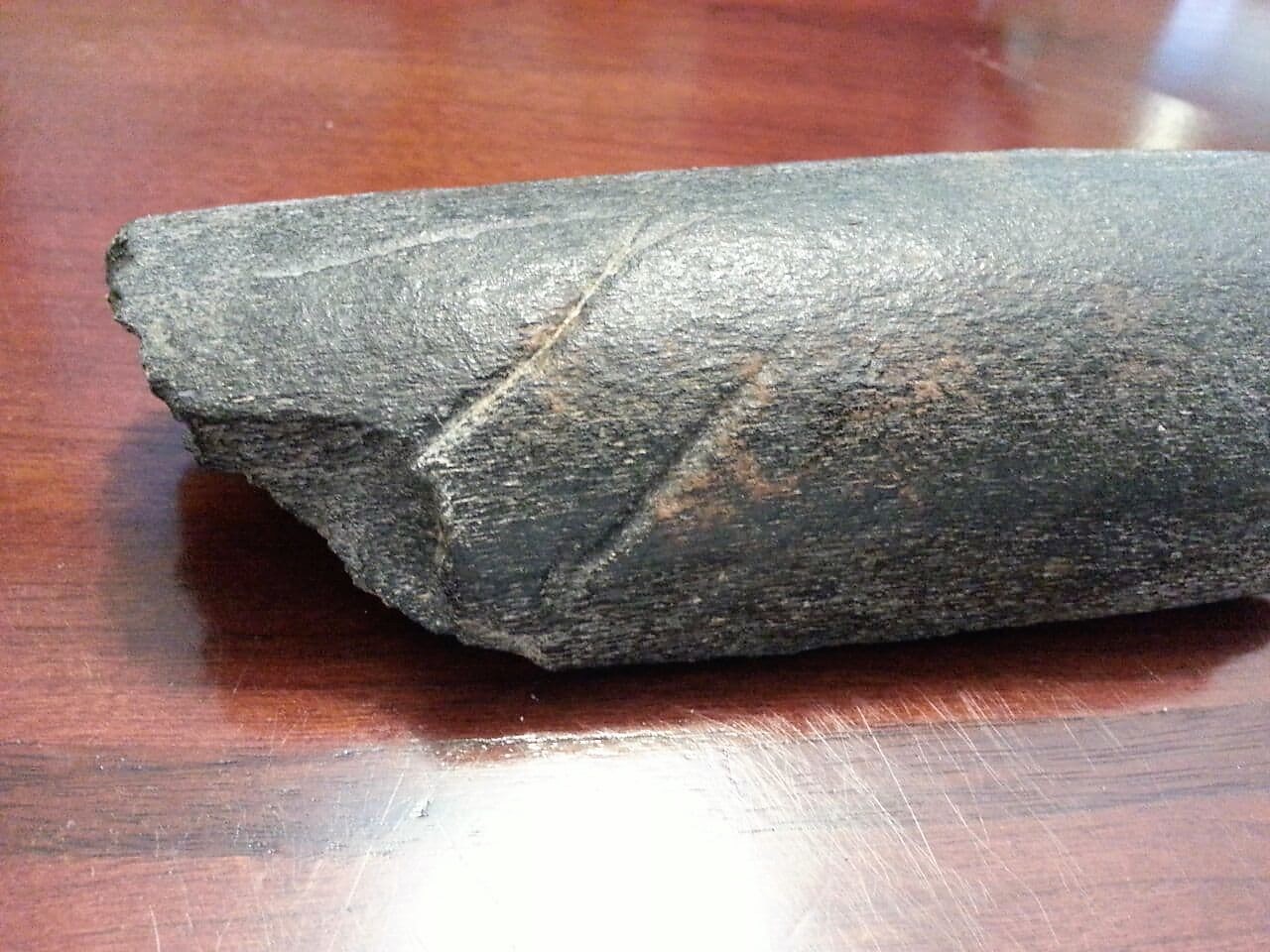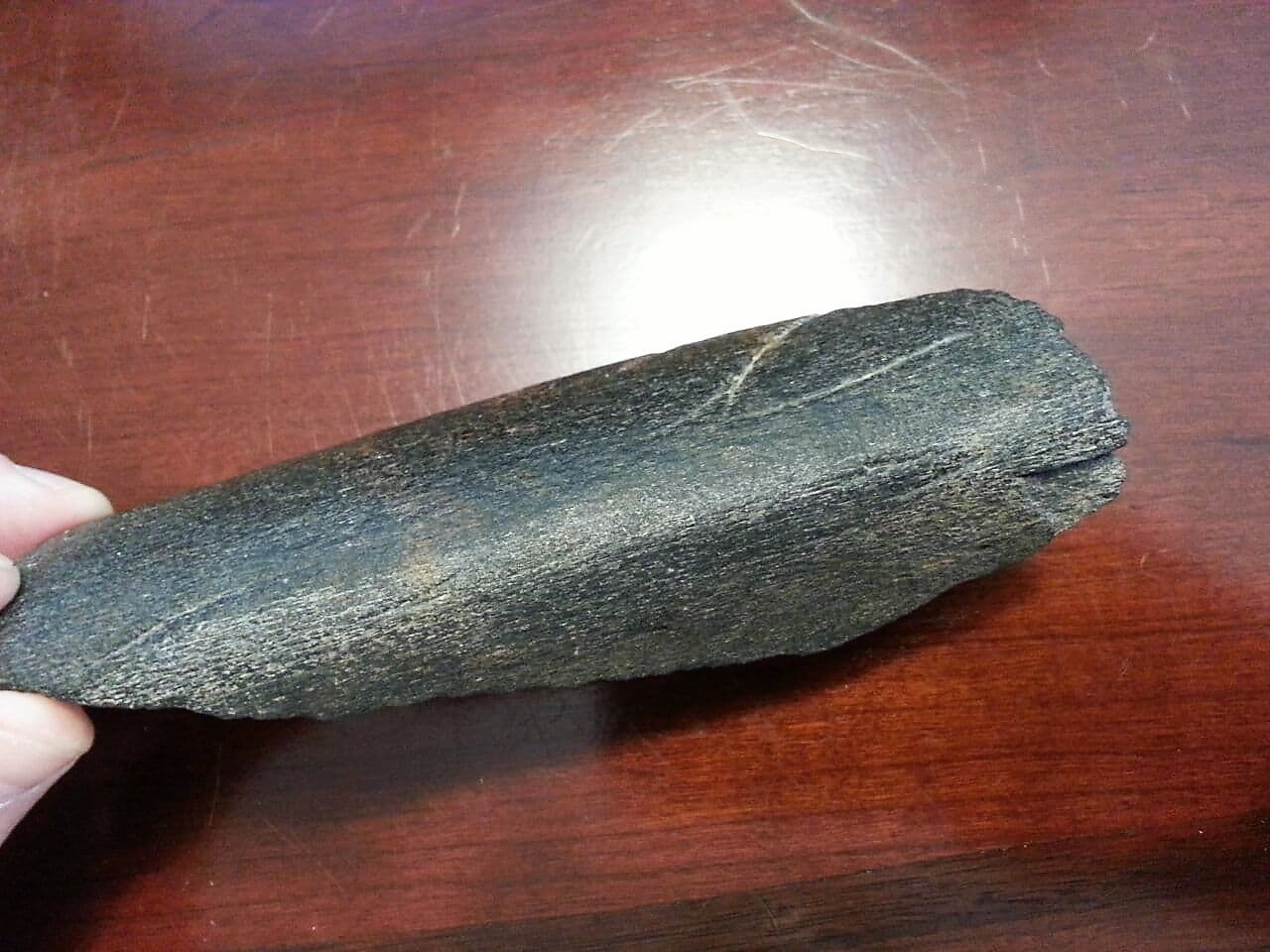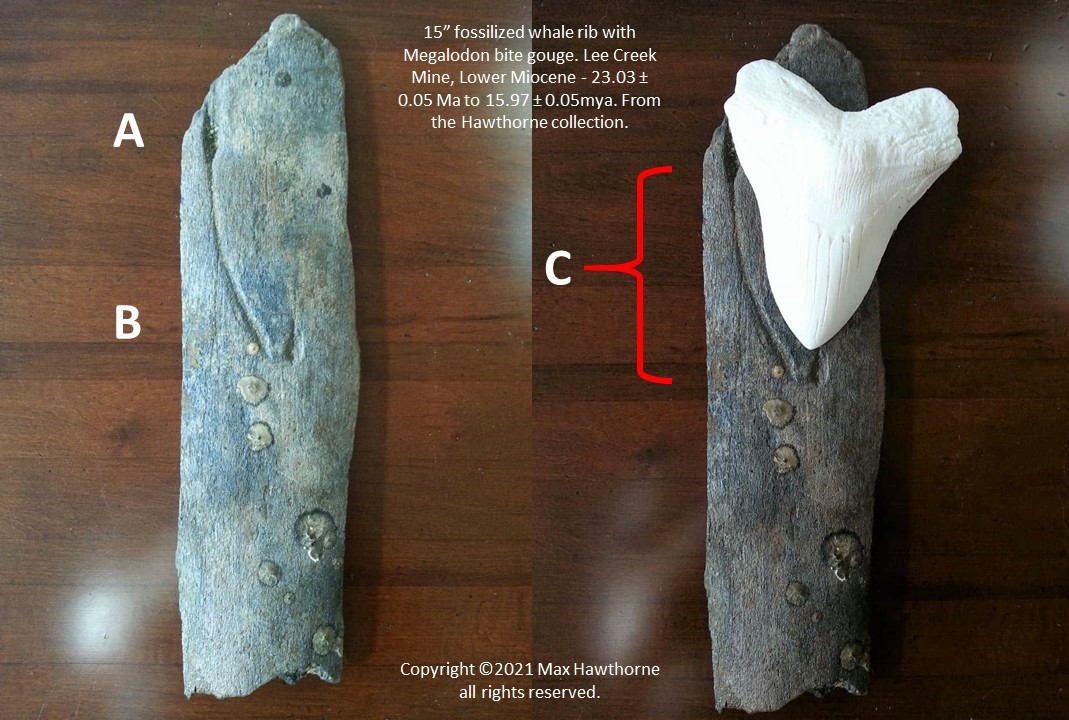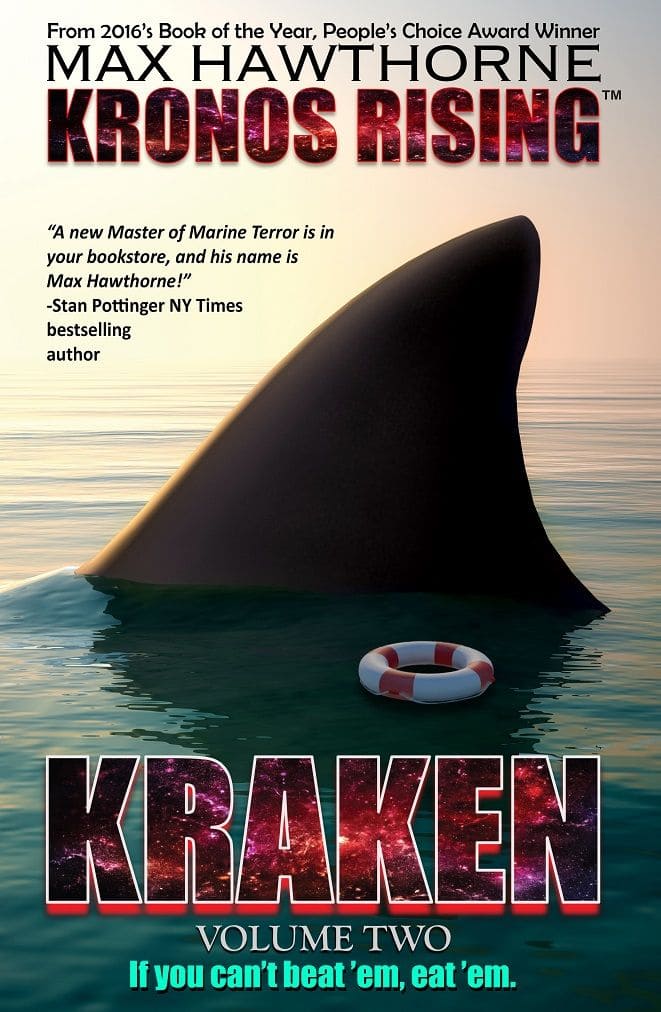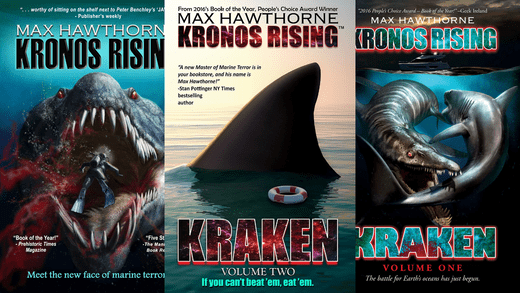What did Megalodon eat? Was the Megalodon shark a slow-swimming scavenger that fed only on carrion?
To answer that question, we must first discuss whether the giant shark was a predator, scavenger, or both. In previous posts, I’ve examined an abundance of evidence that overwhelmingly suggests that Otodus megalodon, AKA the largest of the mega-toothed sharks, AKA the “MEG”, was an obligate scavenger as an adult. In Megalodon: History’s Mightiest . . . Scavenger? I examined the shark’s speed and agility, including limitations it suffered due to the strain its mass placed upon its musculoskeletal system. I also focused on the morphology of its teeth – how they evolved to enable it to scavenge carcasses more efficiently.
In Megalodon Bite: The Secret behind it [Revealed] I explored the shark’s infamous jaws in detail, and focused on how the design of its tooth crowns deviated from that of those found in traditional macro-predatory sharks, such as its ancestor and (for a few million years) contemporary, Otodus chubutensis. I pointed our how the primary maxillary teeth had developed uniquely tapered crowns with cusps that flared out near the robust root. This unique adaptation allowed the shark to insert its tooth tips between the ribs of dead whales like pegs, to more easily bite through ribs. Its jaws had effectively become “nutcrackers”, enabling it to more easily shatter the rib cages of drifting whale carcasses, obtaining the juicy innards smaller scavengers had left behind.
Of course, “extraordinary claims require extraordinary proof”. Predictably, diehard “Minions of Megalodon” have railed against the notion that their 50-foot, 40-ton “super shark” was, as an adult, little more than a lumbering behemoth relegated to oceanic cleanup duty. They have clamored for evidence. And that’s understandable. I mean, without proof a theory is just that, right?
Today, I’m offering proof. In abundance.
Megalodon as a scavenger: the evidence (overview)
As a quick refresher, let’s review the anatomy of the primary (central/outermost) maxillary teeth of Otodus megalodon, as well as that of whale ribs in general. It’s an established fact that whales were Megalodon’s favorite food. And to consume that kind of food it needed teeth that were up to the task. Unlike the blade-like teeth found in the upper jaws of other mega-toothed sharks, Megalodon’s are unique. They are designed like chisels. The crowns have robust cores with a cross-section reminiscent of a flattened cylinder. Flanking these cores are the crown’s flange-like cusps, which are shaped like curved blades with tiny, hacksaw-like serrations (see image below).
 Author’s analysis of the primary maxillary teeth of Otodus megalodon.
Author’s analysis of the primary maxillary teeth of Otodus megalodon.
The purpose of these crowns was to act like organic log splitters, except they were splitting ribs instead of sections of tree. When it comes to feeding, a shark’s jaws function like a fork and knife. The lower jaw has slenderer, more pointy teeth that spear the prey item, immobilizing it, while the upper jaw hyper-extends and comes down in a shearing motion. In the case of Megalodon, the central teeth in the upper jaw evolved to slip between the ribs of dead whales (live whales tend to frown on that sort of thing) like a person interlocking the fingers of both hands. There would be a brief feeling-about process, with the shark mouthing the carcass in order to get the right fit. Once that was accomplished, maximum pressure was applied. The narrower crown tips moved deeper between the individual ribs, until the flange-like cusps impacted on the rib bones on either side. As the shark brought the power of its jaws to bear, the cusps began to slice into the ribs from either side, like a pair of handsaws cutting through wood. It was a sandwiching attack, and eventually the ribs shattered, enabling the fish to gouge out a huge mouthful of internal organs (heart, lungs, etc.) and bone fragments.
The serrations
Discussions directed at my analysis of the micro-serrations on Megalodon teeth have come up. Would-be detractors of my theory have claimed I stated the serrations shrank over time (a deliberate misinterpretation), and that there are simply more of them present on larger teeth. This, therefore creates the illusion of tiny serrations. That’s just silly. It isn’t a question of whether the serrations reduced in size over time – they were small to begin with. It’s determining whether they were designed to slice through flesh, a la the steak knife teeth of Carcharodon carcharias, AKA the great white shark, or if they are, as I have stated, adapted to shearing through harder substances, i.e. bone.
The proceeding image is a comparison between a near-three-inch white shark tooth from my collection and a similar-size Megalodon tooth. It is obvious that there is a substantial difference in the coarseness of the two teeths’ respective serrations. The white shark’s serrations are far larger, and its teeth are designed as dagger-like meat slicers. Their primary purpose is to inflict hemorrhaging wounds which cause the prey item to quickly exsanguinate, like when the fish attack attacks the haunches of an elephant seal. Their secondary purpose is the processing of flesh and blubber. Even at 20+ feet, the white shark is incapable of biting through large whale bones. Instead, it feeds on the softer portions it is capable of biting through, mainly muscle and adipose tissue, and sometimes flukes and flippers.
The Megalodon tooth, on the other hand, when viewed in terms of its overall lines, is not as triangular as that of the great white. Even with a tooth less than 4 inches in length (corresponding to perhaps a 30′ shark), there are telltale signs of the morphological changes which will one day enable it to shear through huge rib bones. The crown tip is proportionately narrower compared to the overall crown, and the cusps are starting to develop tapered arcs that, in an adult, will function as rib wedges. Lastly, the serrations are incredibly fine. This indicates that the shark’s teeth were primarily bone saws – designed to process carcasses instead of disabling live prey. Of course, their secondary purpose is, as with the great white, to process meat. But, in this case, instead of blubber, much of said protein would consist of putrescent gobs of decaying whale organs, mixed with chunks of shattered rib bone.
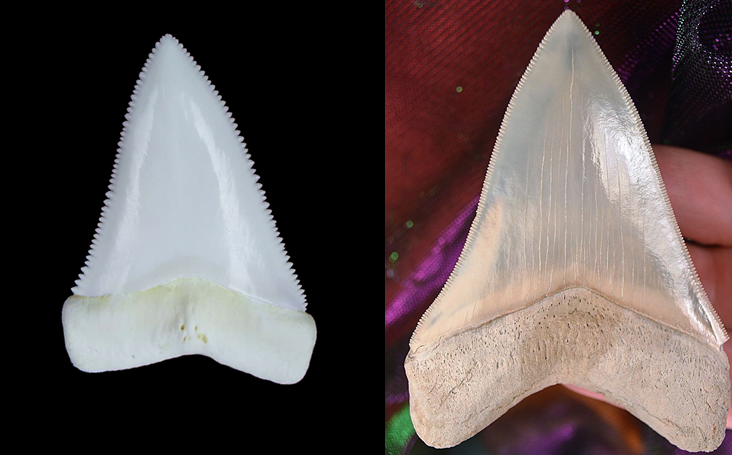
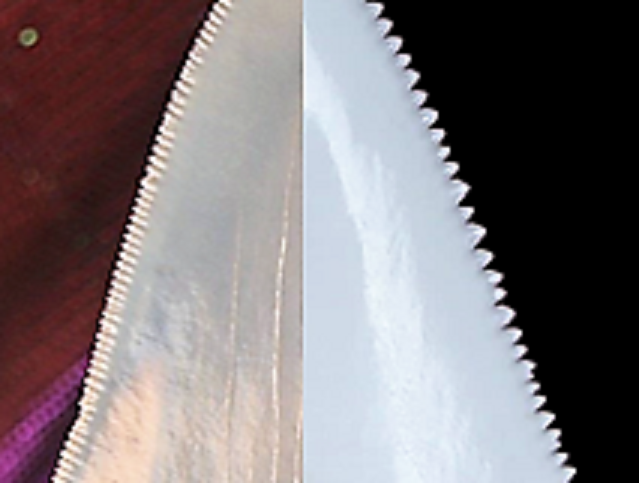
When it comes to serration size, we see the same thing with smaller teeth. In this case, a two-inch white shark tooth is compared with an Otodus megalodon tooth measuring 2.4 inches. (Note that the crowns of these two teeth are similar in size, however, the fossilized tooth has a larger root which adds to its LOA) Once again, the serrations on the white shark tooth are far more robust, on the “Meg”, smaller and finer. This isn’t an illusion, it’s a fact. One is designed to carve flesh, the other, to slice through bone.
The tooth crowns
When addressing the question, “What did Megalodon eat?” we must also take into account overall tooth design. Crown shape and robustness was also a factor. For example, in both of the large primary maxillary teeth below (from my collection) we see very wide crowns with massive roots. This is for increased stability when biting through rib bones. In addition to the extreme width at the base, the crowns demonstrate significant tapering, yet the crown tips themselves are quite robust – almost chisel-like. When compared to the tooth of a great white (red overlay) we can see immediately that the teeth have blunter tips – a far cry from the dagger-like maxillary teeth of the white. These teeth are designed to be wedged into places and subjected to high levels of stress without breaking, i.e. bone chisels/wedges. It’s not a matter of saying, “Oh, the teeth had to be that thick because they were so big.” No. Otodus chubtensis had teeth sometimes 5 inches long, yet they had much thinner, more blade-like crowns. In this aspect, they were far more like the teeth of the great white shark than Megalodon’s. This suggests that, whereas Megalodon was primarily a carrion eater as an adult, Otodus chubutensis managed to stay more of a hunter.
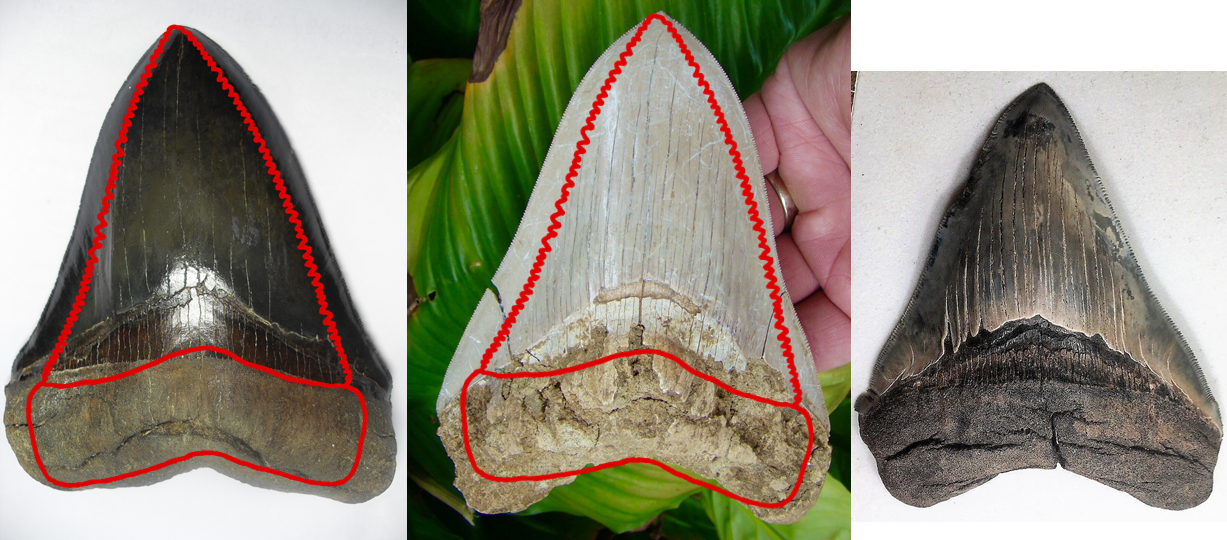

In the above photo, we see a maxillary tooth tip from Megalodon compared to a scaled-up maxillary tooth from a white shark. Note the difference in shape. “Meg” teeth tend to be much more rounded near the tip than the white’s, more like an oval with a point at one end. The range varies from specimen to specimen, but the proportional increase in breadth is always present, with the extinct shark’s primary maxillary teeth often being more than 1.5X as wide. This demonstrates that the tooth crowns did, indeed, evolve to be broader. This also supports the theory of the maxillary teeth being used as rib splitters. The extra width was needed to reinforce the crowns, as they were regularly subjected to compression from both sides as they were jammed between whale ribs. Whereas the other teeth in Megalodon (secondary maxillary and mandibular) tend to be built more like robust, scaled-up white shark teeth, the primary (center) teeth feature these unique adaptations to their crowns that overwhelmingly suggest that they were, indeed, bone wedges/rib splitters.
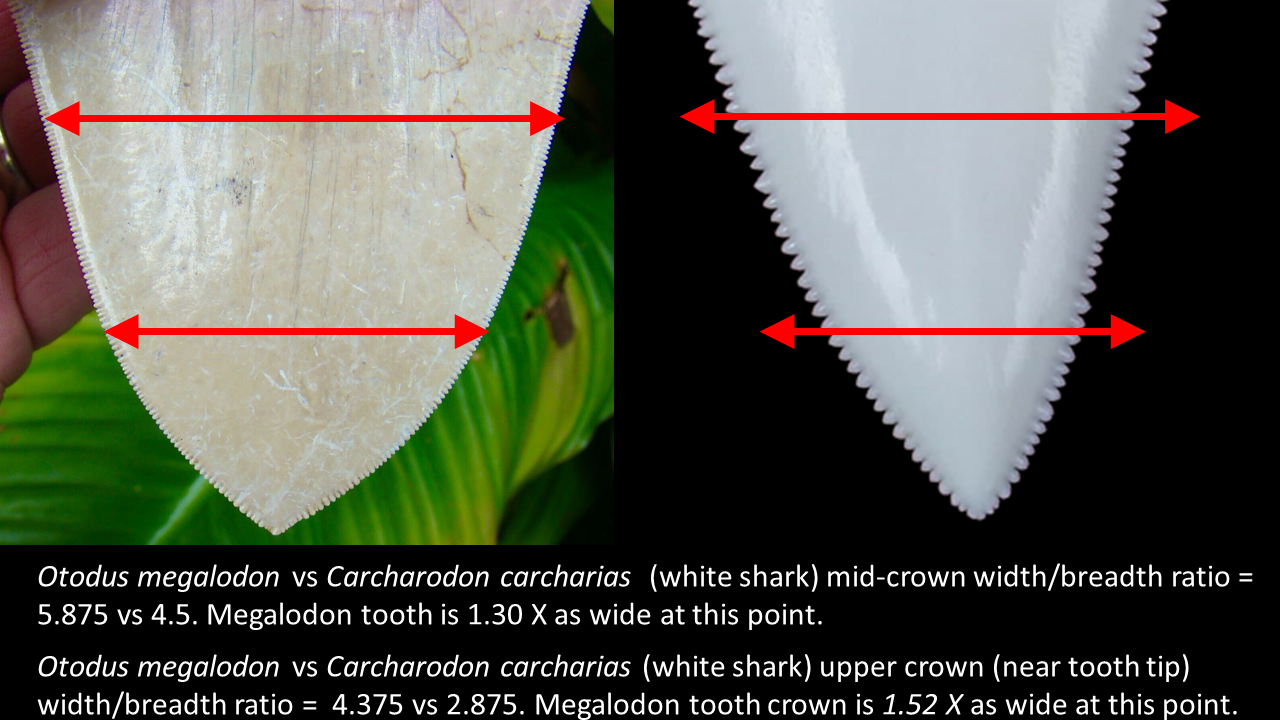
The whale ribs
Three of the four whale rib fragments utilized for this study (most likely members of the family Cetotheriidae) were discovered in the Morgan river, near Beaufort, South Carolina (Miocene/Pliocene ~ 2.6-15 mya.). Amusingly, they came from the Hawthorn Formation. The third is from a far larger, unidentified cetacean and hails from the Phosphatic Miocene Strata of the Lee Creek Mine, North Carolina. Lee Creek is an open-pit phosphate mine on the south shore of the Pamlico River which exposes: Pungo River Marl (Lower Miocene – 23.03 ± 0.05 Ma to 15.97 ± 0.05 mya). All rib fragments bear tooth gouges, the size and depth of which overwhelmingly suggest they were inflicted by O. megalodon. The presence of the rib fragments in brackish, present-day riverine environments aligns with schools of thought that state that gestating female sharks traveled to shallow, coastal regions in order to safely birth their pups. The length, depth, and positioning of the assorted gouges indicates that the bite marks were the result of non-frenzied-style, posthumous feeding, most likely caused by the scavenging activities of large, sexually mature female sharks.
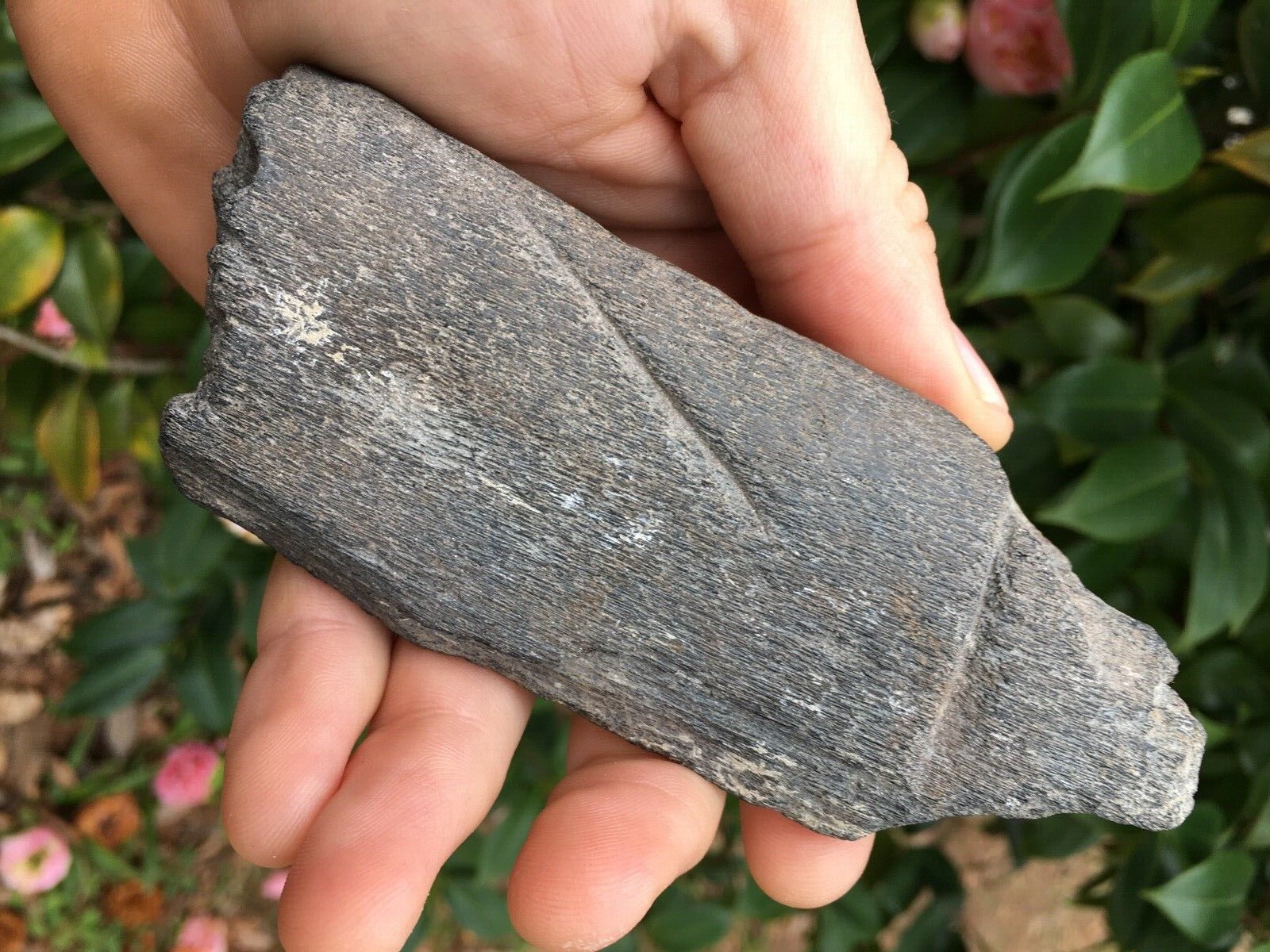
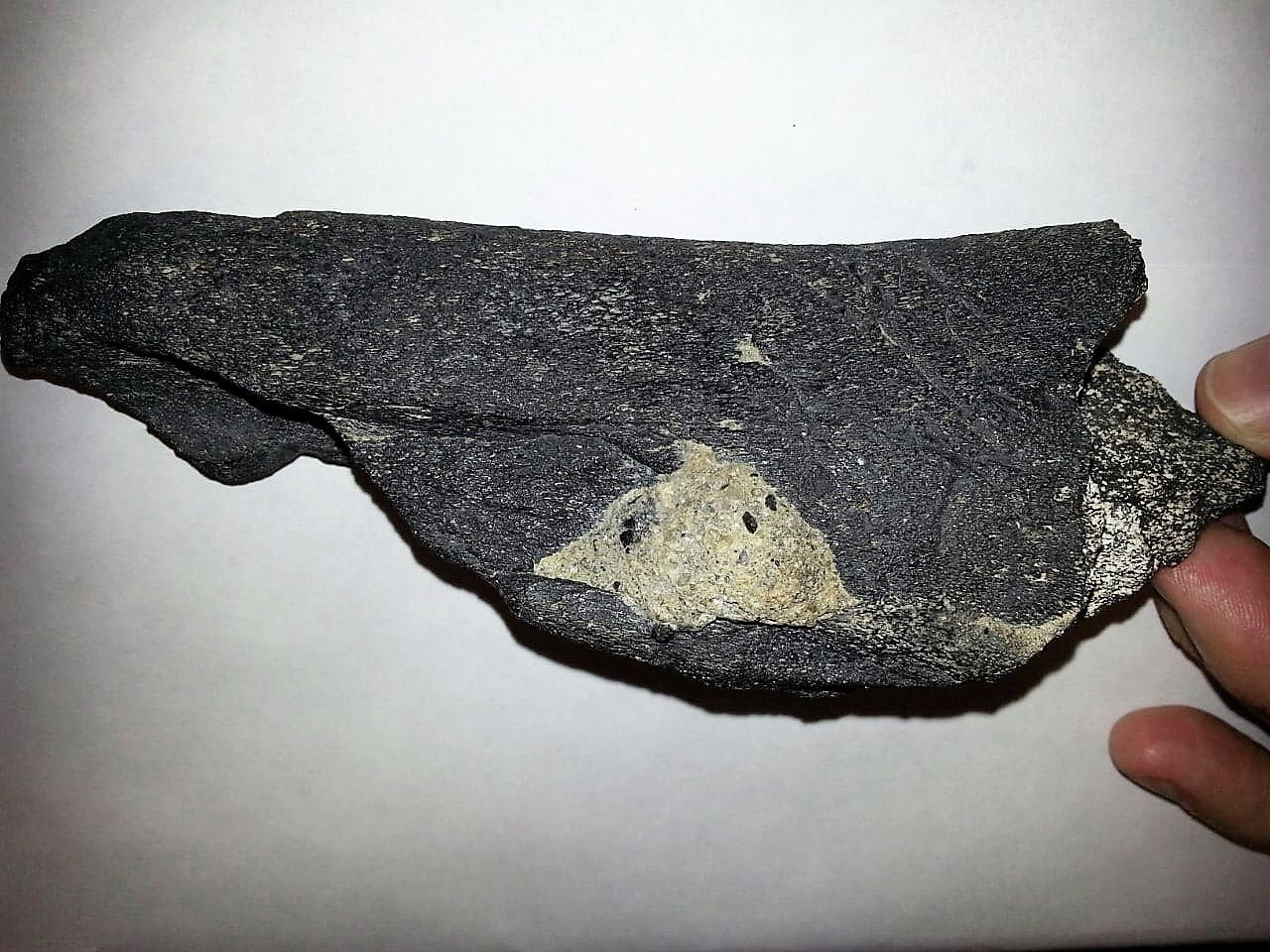
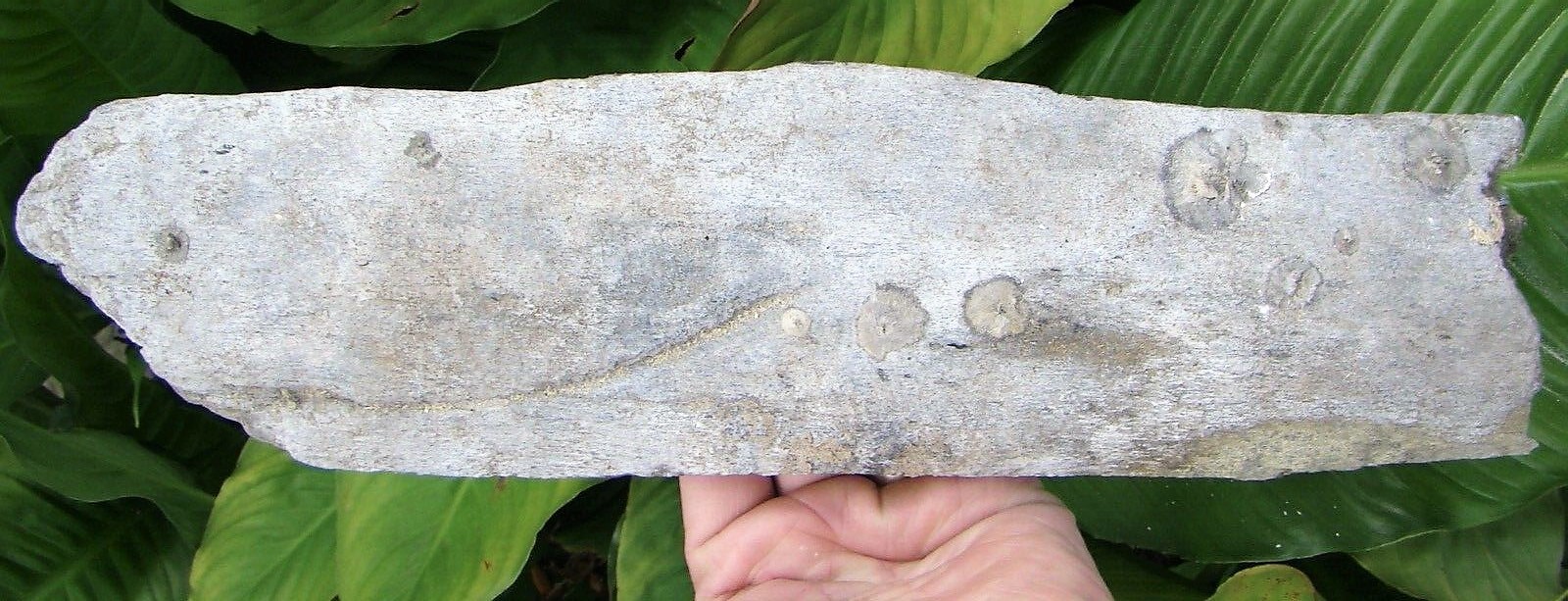
In order to confirm that my Megalodon “nutcracker-style” feeding technique came into play with these fossils, we must examine the ribs in order to determine how the bites took place. With fragments this size, positioning is difficult, to say the least. The carcasses may have been right-side-up or belly-up when feeding commenced, and undoubtedly rolled around as the shark positioned its meal. Still, by studying the gouge pattern, we can determine with reasonable accuracy the position of the shark’s jaws as it fed.
Exhibit A (whale rib “A”)
This first rib fragment is remarkably telling. First, an overview. The fragment bears multiple tooth gouges, with one terminating in a fissure/fracture that caused the rib to literally come apart at the seams. The evidence suggests that the rib shattered into pieces as a result of the combined compression/cutting forces applied to it. Much of the surrounding rib bone was undoubtedly swallowed incidentally by the shark as it gouged out huge mouthfuls.
The next image represents the rear portion of the fragment. The flattish portion in the foreground indicates the interior (organ protecting) or inside part of the rib. The tooth gouges are all present on the curved lateral (side) outer portion, i.e. the part of the rib closest to the whale’s outermost covering of skin and blubber.
Based on this evidence, we can safely assume that the deep grooves present (see photo below) were caused by the Megalodon’s maxillary (upper jaw) teeth. This is because we know that the shark’s feeding method (biting) is a fork-and-knife affair. The pointier, more slender mandibular (lower jaw) teeth execute a stabbing motion, puncturing the body of the prey item, and pinning it like a fork does. Then, the broader, more blade-like teeth in the upper jaws (maxillary) extend out and bear down, carving through ribs and excavating flesh. The long gouges were undoubtedly caused by maxillary teeth. Again, whether the carcass was inverted or not is impossible to say, but we can deduce that the shark’s upper jaws bore down on the dead whale as indicated, and in a manner where the teeth in the upper jaw ran parallel to the ribs, i.e. in a vertical, up and down pattern.
Now let’s look at a side view of the rib fragment and analyze the respective cuts (tooth scores).
A: Indicates an exploratory bite. We know this because the gouge came to an abrupt end without fracturing the rib. Again, as the shark attempted to feed, it needed to get past the rib cage in order to access the dead whale’s heart and lungs. There would have undoubtedly been a “feeling out” process as it worked at fitting the narrower tips of its tooth crowns between several of the dead whale’s ribs. In this instance, it probably didn’t have the other central teeth properly positioned and its jaws continued to gnaw and flex as it tried for a proper grip. Think of yourself as trying to put a glove on in the dark; you’re feeling for your fingers to properly insert into each of their respective holes before you slide your hand successfully inside. If your fingers are not inserted properly, at a minimum you’d be uncomfortable.
B: Indicates a successful bite that ended with complete rib fracturing. This supports my theory that, after achieving a proper “lock on”, the cusps of the shark’s tooth crowns had the whale’s ribs successfully sandwiched between them. The shark felt/sensed this and then applied maximum bite force (currently estimated at between 24,400 and 41,000 foot pounds*), with the compressed ribs splintering and shattering. In the proceeding images, you will see indicators highlighting the explosive forces that were generated, and how they spread like a fault line throughout the bone.
C: Either another exploratory bite with the edge of the tooth crown near the tip leaving a shallow slice on the rib’s flank portion, or the fragment being scored after primary bite “B” had taken place. In the latter scenario, the loosed fragment may have been grazed by a tooth crown as the shark bit into a mouthful of fetid flesh. The fragment then spilled from its mouth, before spiraling down to the seabed.
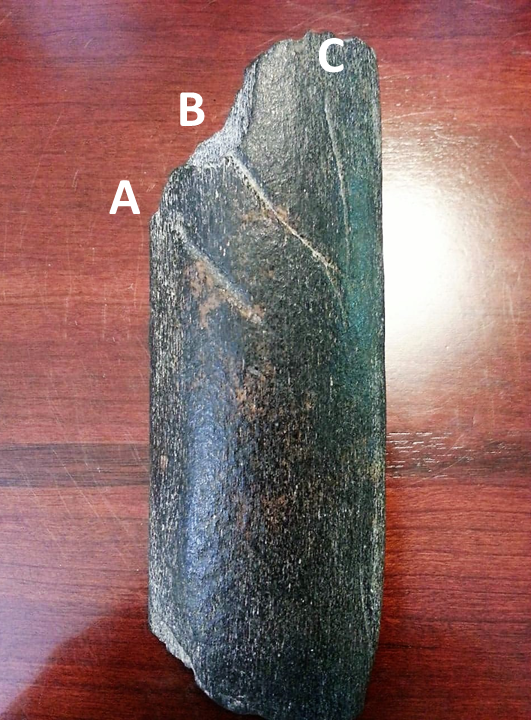
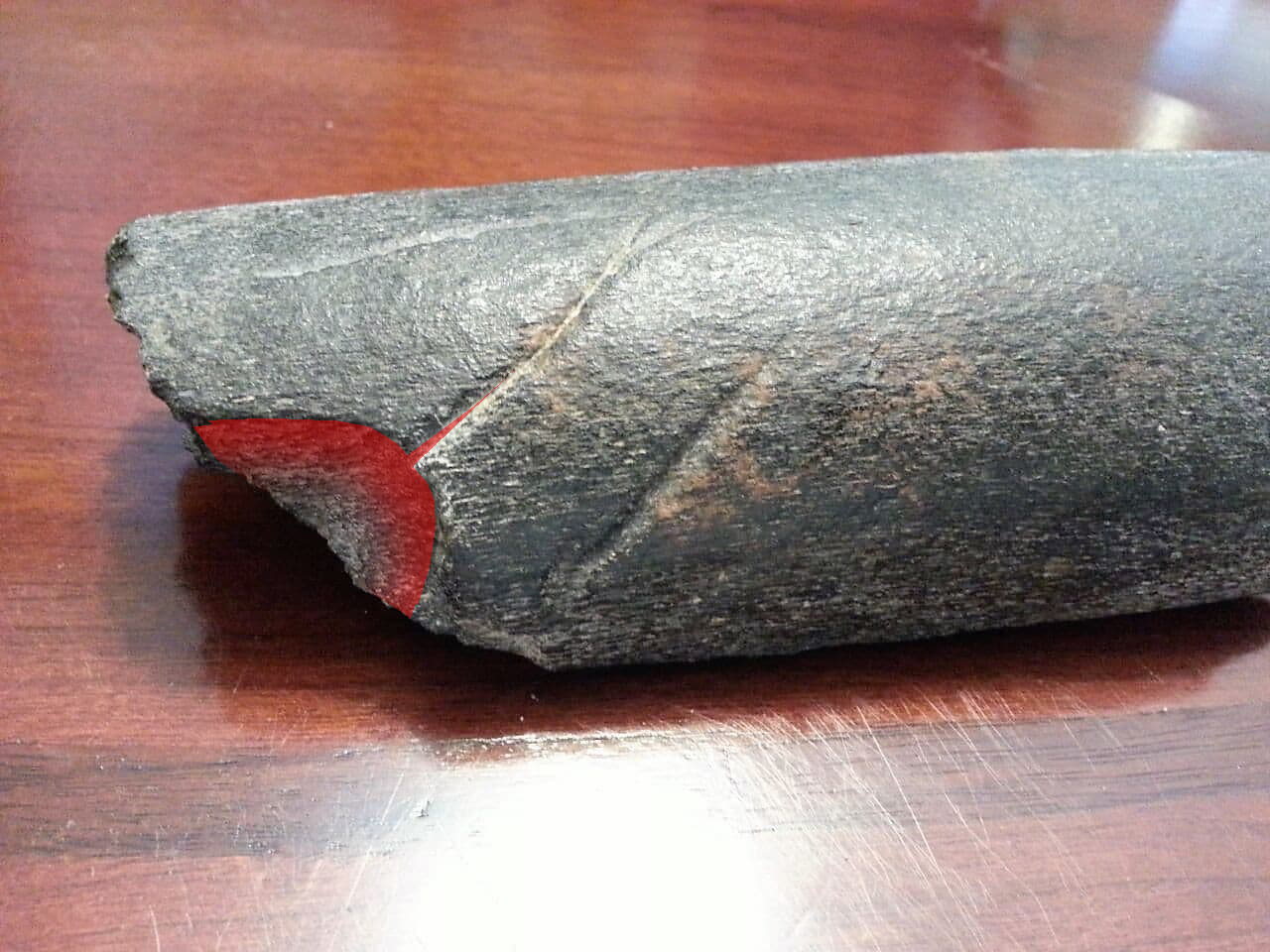
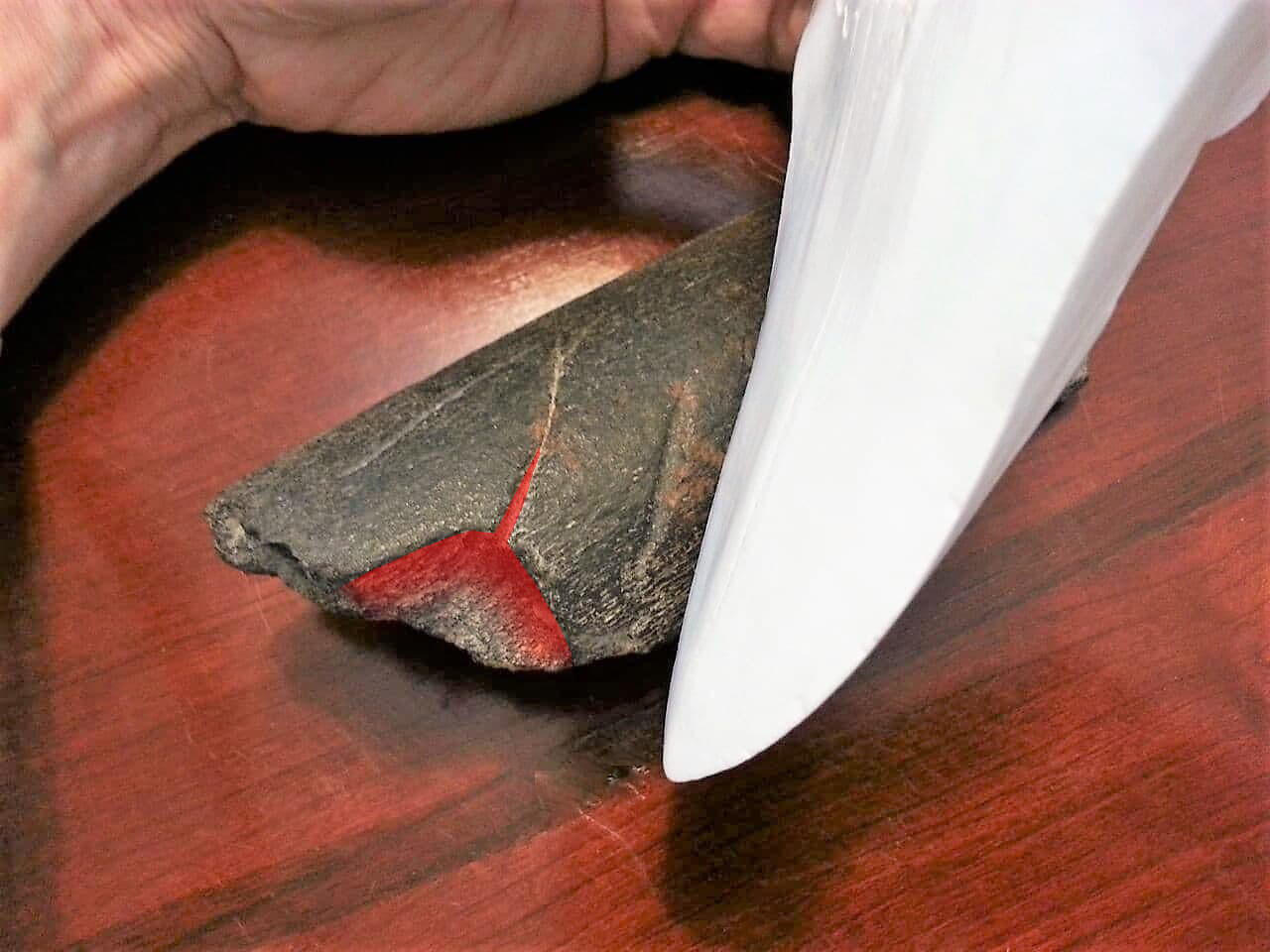
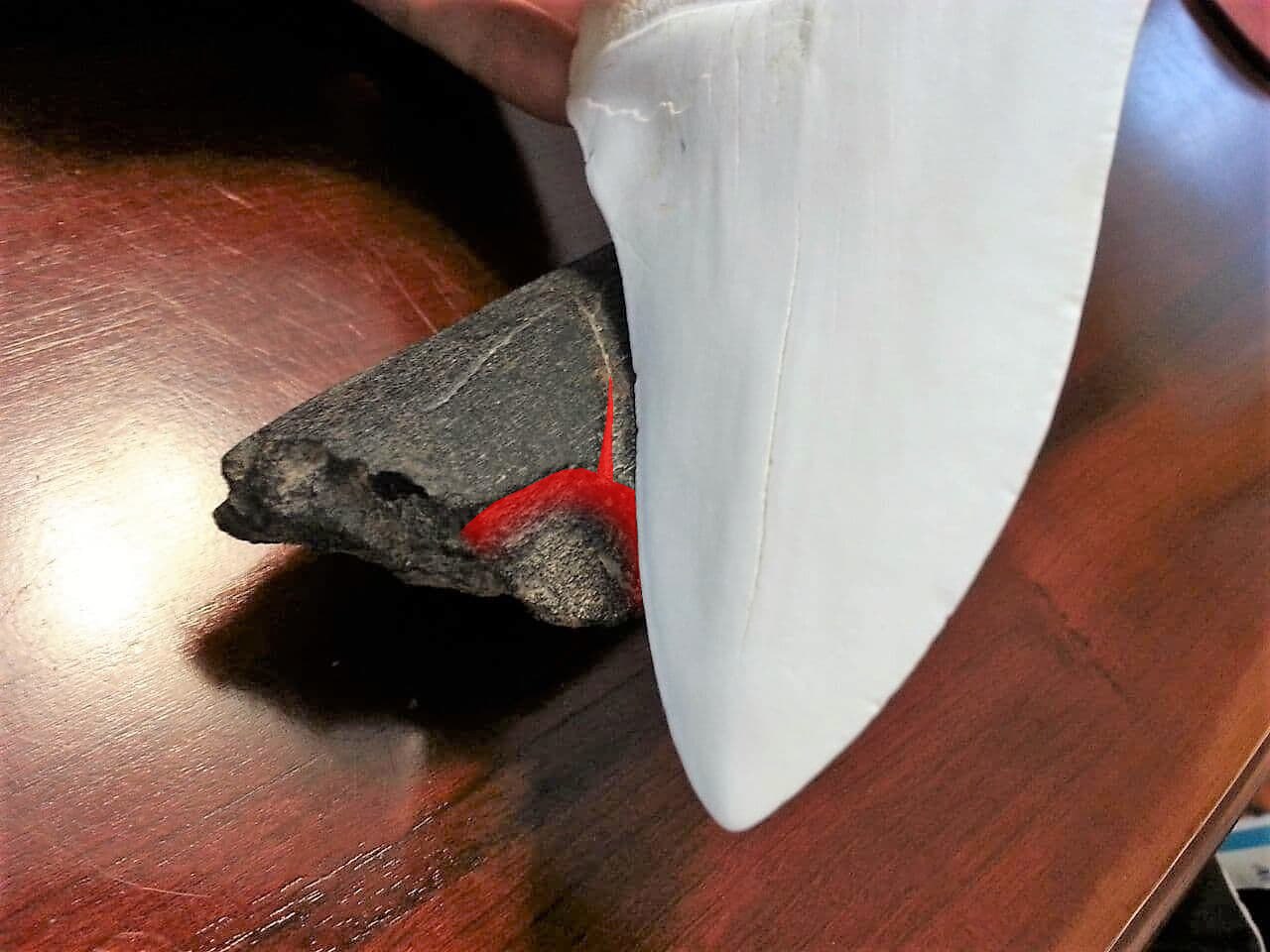
Exhibit B (whale rib fragment “B”)
Rib fragment two (“B”) tells the same story. In this case, the fragment is of similar size to fragment “A”. Again, we see multiple tooth gouges – two this time – with the second terminating in a fissure/fracture.
“O” represents the outside edge of the rib.
“I” represents the interior (flat) portion of the rib that protected the cetacean’s internal organs.
“A” is the first tooth gouge. Note that the scoring is fairly light and, once again, does not end with the rib shattering. This is, again, indicative of a feeling-out bite. The shark was clamping down and trying to insert the tips of its maxillary teeth between the ribs for a more efficient and less self-damaging bite. Whale bones are dense and the shark’s jaw bones are made of cartilage. This left its teeth vulnerable to dislocation and breakage, hence care was taken before the full power of the jaws was brought to bear.
“B” is the second and final tooth gouge. Note that it is far deeper. It is also more vertical than bite mark “A”, or any of those found on the previous fragment (“A”). This suggests two things: 1- when the Megalodon went to eat, the whale’s carcass rolled as it attempted to lock-on. And 2- that this was a comparatively small cetacean (est. ~20′ in length) and the shark was quite large. Once it had adjusted its grip it was able to completely encompass the carrion’s rib cage, before biting clean through it to access the remaining internal organs.
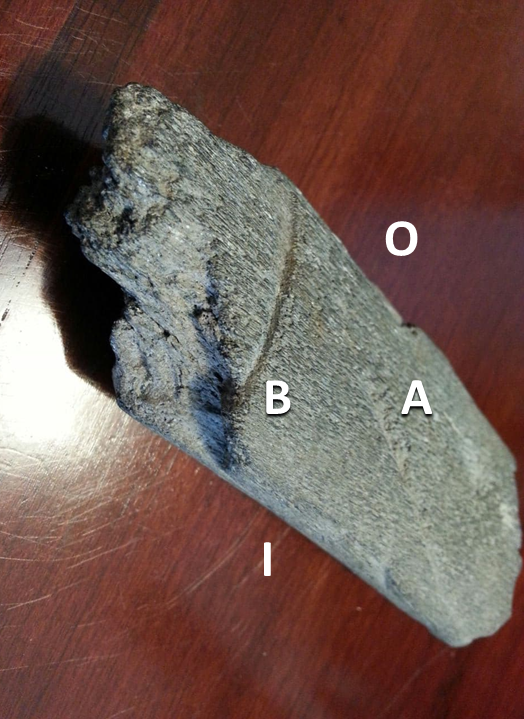
In this next image, we get an idea of how this feeding took place. The replica tooth being used is over 6 inches in slant height, suggesting a female shark ~45 feet. Labial (non-display) surface of the tooth is visible. The bite(s) came from the direction of the arrow, with the first bite – again, most likely an exploratory one – grazing the rib. The carcass most likely began to roll in the water, with the teeth in the shark’s lower jaw digging in to stabilize it. At this point, the maxillary teeth locked on with the crown tips successfully fitted between the ribs. The jaws then bore down. The resultant, deeper groove (B) not only scored the bone, it ended in a fracture as the rib once again split apart.
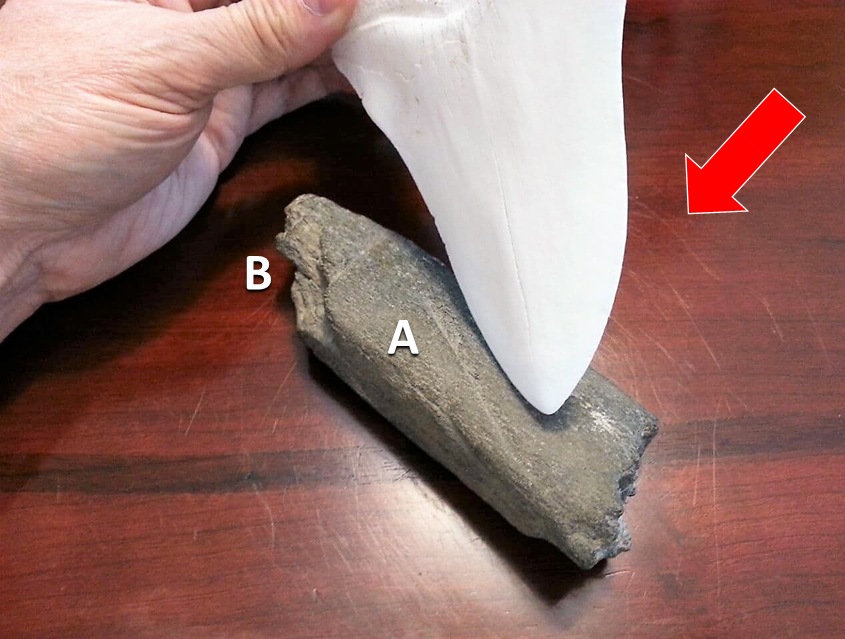
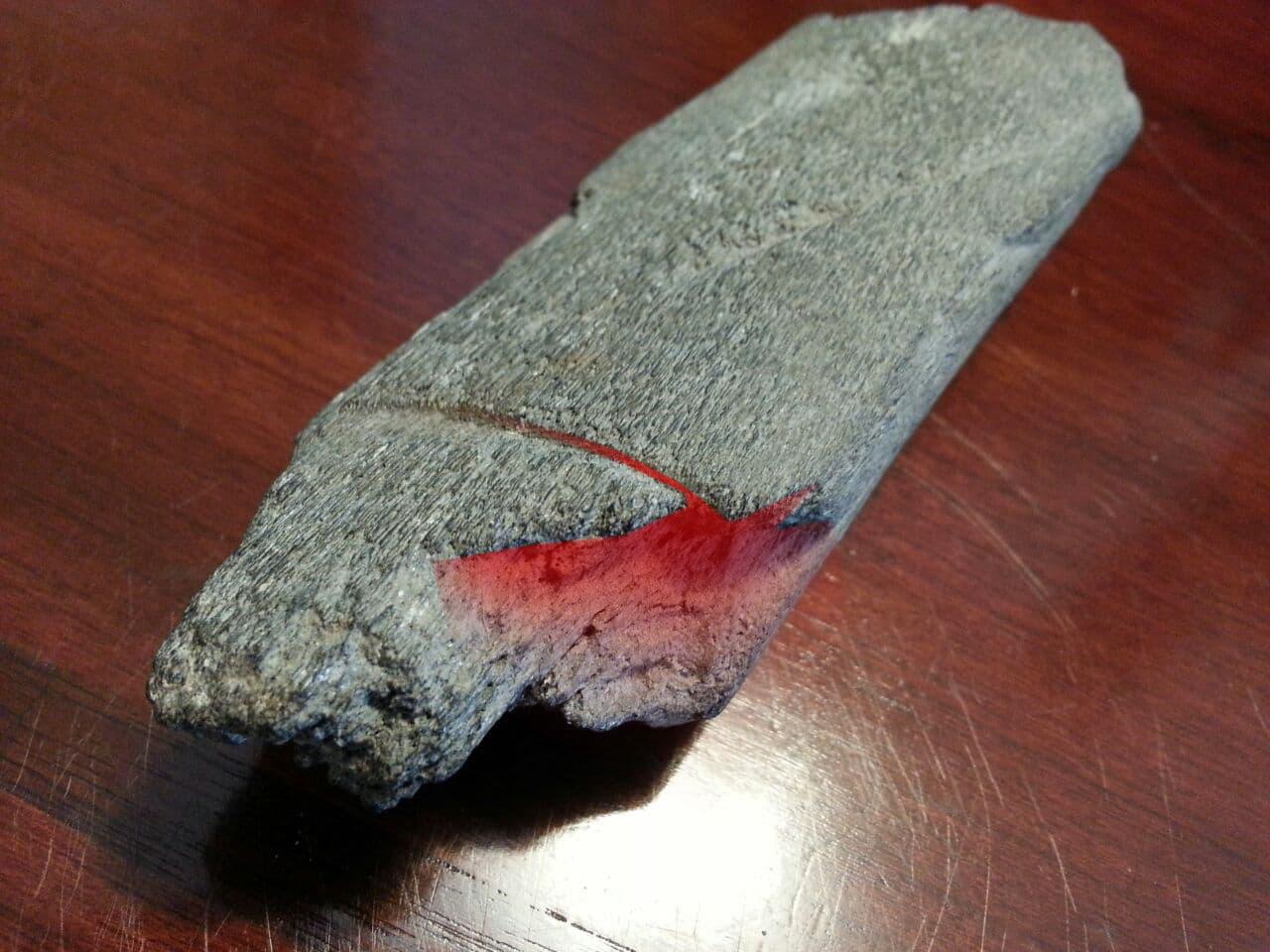
Exhibit C (whale rib “C”)
Rib fragment three is a valuable addition to our sampling base. Unlike in the previous fragments, wherein the ribs had shattered both vertically and horizontally, with the remaining fragments showing telltale feeding traces on only one side, this section of rib exhibits bilateral feeding damage, i.e. tooth scores on both sides. This confirms the mega-toothed shark’s tendency of fitting its teeth between the ribs of drifting whale carcasses prior to biting down. The actual feeding traces are indicated by the red arrow, with the exterior surface of the rib indicated by “E” and the interior by “I”. It is impossible to say whether the rib came from the left or right side of the whale’s body, so any notion of superior or inferior positioning is contraindicated. For purposes of this study, I have labeled the sides “A” and “B”. The shark’s primary maxillary teeth were fitted between the ribs, as exhibited by multiple tooth scores on both A & B (or, if you were facing the whale’s rib cage, Left and Right). Interestingly, the scores line up perfectly; the gouges would have met, were they allowed to continue unabated until intersecting. This was the result of the cusps of the tooth crowns involved growing ever wider as the bite took place, again supporting the theory of the shark’s teeth specifically adapting as bone wedges to aid it in scavenging.
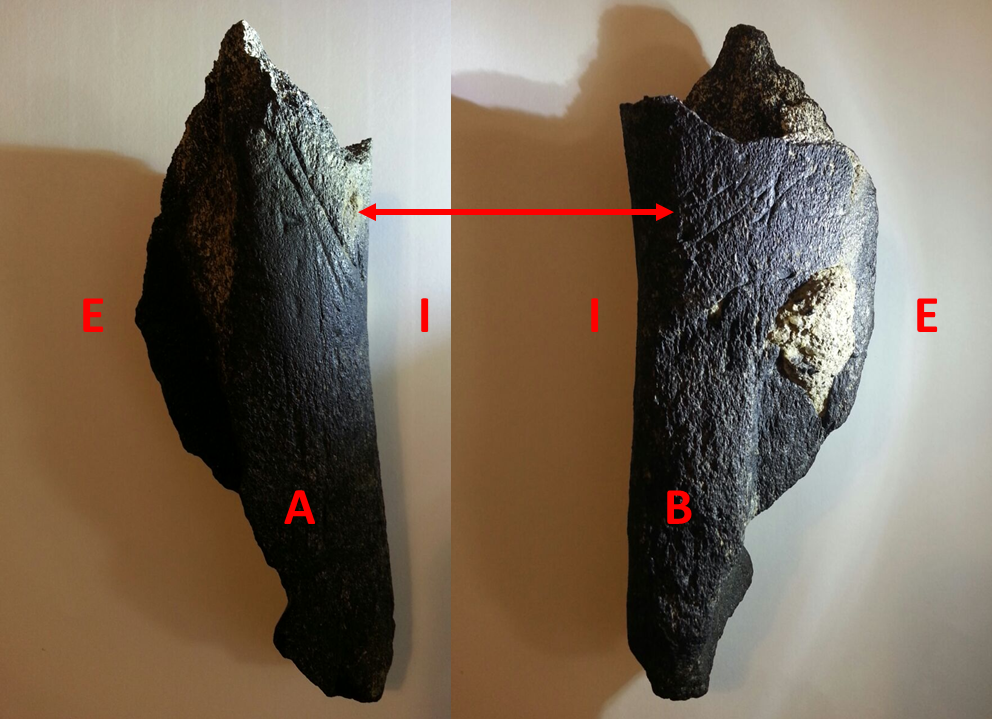
Exhibit D (whale rib “D”)
Rib fragment four once again demonstrates the feeding habits of Megalodon, albeit on a larger scale. Although the fragment indicates a much bigger cetacean of some kind (est. ~40 feet), we see the same type of damage. There is a single, elongated groove (“A”) carved deeply into the bone; again, courtesy of the finely serrated crown edges of Otodus megalodon. And, again, we see the familiar splitting/fracturing as sandwiched ribs ruptured from the mega-toothed shark’s uniquely adapted teeth. The rib fragmented at the distal portion. Also of note is a tooth puncture (“B”) which was likely caused by the same shark – feeding damage as it consumed a mouthful of flesh. Lastly, there are scars on the bone caused by bivalves which affixed themselves to the bone after whale fall took place, and what was left of the carcass was left to rot on the seafloor.
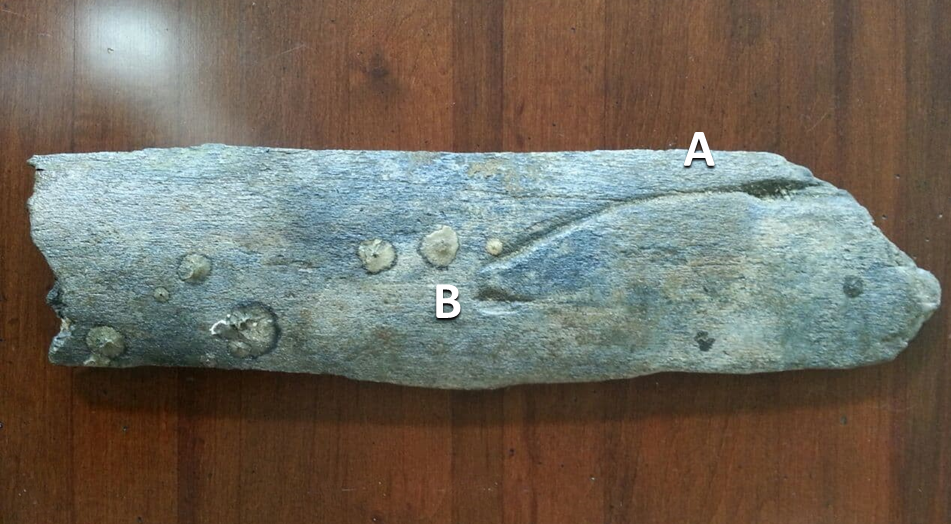
The above photos provide a view of the Lee Creek Mine rib section, with the second including a replica cast of a six-inch Megalodon tooth for size comparison. When seeing evidence like this, we don’t have to ask, what did Megalodon eat? We know what it ate. We have evidence, and in abundance. Note the heavy scoring on the rib’s flank in the first photo, with denotations A and B. B shows deep scoring in the bone – the stereotypical curving bite of an adult Otodus. Seen from the side, it becomes clear that the crowns of the shark are not straight like those of a great white. Rather, they have a slight curve to them, like a schoolyard slide. This is likely due to the fact that the shark’s jawbones (maxilla/mandible) are semi-flexible. Hence, while under heavy load, the teeth undoubtedly had a tendency to flex from where they emerged from the jaw. The natural curvature of the teeth allowed them to carve an arcing path in the bones of their quarry that compensated for this deviation, letting the teeth function like hacksaws, slicing into and weakening ribs.
Note also “B” (above left). This shows a fissure that formed in the bone as the widened cusp of the tooth dug in. The cut widened as the sharp-edged cusp dug deeper and the crown thickened. Coupled with the next-over maxillary tooth sandwiching the rib from the other side, this caused it to split and break apart, like a steel wedge or log splitter being hammered into a section of log. This is, again, characteristic of the bone chisel biting technique of an adult O. megalodon in scavenging mode. We see this time and time again. The narrower distal portion of the crown fits between the teeth and slides in. Then the cusp begins to cut into the rib, going deeper and deeper and backed by its brethren, until the rib splits and shatters.
In this particular specimen, note that the end of the rib where the fissure split it apart is like a fault line. It is drastically different than the break we find at the opposing end. The break at that point was shattered via lateral pressure, once the initial break left the arc-shaped rib vulnerable (sort of like you “walking the plank” on a piece of wood that is incapable of bearing your weight).
Note “C” (above right). Again, this is a cast of a 6″+ upper from a large Otodus megalodon. You can see how the cusp lines up with the fissure that a tooth like it created during the scavenging process. It is interesting to note, however, that, based on the distance from the top of the initial cut and the fissure caused by the cusp, that the tooth that did this damage appears to have been larger – probably +/- seven inches. This suggests an exceptionally large shark, probably in the fifty-foot-plus range. This makes sense, as the cetacean itself was quite large, and the fish preying on it would, per force, had to have had exceptionally large teeth and jaws to order to successfully utilize its bite-wedge technique.
The Mechanics of Megalodon’s Bite
When it comes to Otodus megalodon, we need to keep in mind we’re dealing with an enormous animal that, once fully grown, gets almost all of its calories from carrion. An adult Megalodon shark would have been slow – basking shark speed at most – and possibly as slow as a Bowhead whale, which normally swims at 1-3 mph and has a top-end speed of 6.2 mph. *
Such a speed for a 40+ ton shark with a skeleton made of cartilage is eminently plausible. It’s in the range for such leviathans as the whale and aforementioned basking shark. Not to mention, we’re dealing with a creature whose “hunting” consists of using its phenomenal sense of smell to travel from carcass to carcass. It has no need for speed. It has few natural enemies, and its food isn’t going anywhere.
A Megalodon feeding on a carcass would have been a surprisingly placid, albeit grisly, affair. It would have sensed the carrion from many miles off, and, depending on distance and current, might have taken hours or even days to reach it. As it drew near, other predators/scavengers would give way. The rare exception might be two adult sharks arriving at the same time, in which case, the smaller would most likely give way to the larger, as in white sharks. The dominant fish would approach the remains, scanning for sections that still contained flesh and blubber. Given that Megalodon’s prey consisted of smallish whales typically ranging from 20-30 feet, that might prove problematic. Whatever killed the cetacean would’ve already eaten the choicest parts, with scavengers stripping away much that remained. The bulk of available flesh would most likely consist of the dead whale’s heart and lungs, tucked away inside its jail-cell-like rib cage.
The shark would mouth the rib cage, attempting to lock on. Its teeth weren’t deeply rooted in bone, like the teeth of the raptorial sperm whale Livyatan, or the Mesozoic marine reptiles known as pliosaurs. Instead, they were loosely embedded in jawbones of cartilage. Thus, a sudden, powerful impact and bite, designed to crush the rib cage, as some Wikipedia contributors have suggested* is contraindicated. Such a strike could have caused the shark to lose numerous teeth, teeth it needed to consume the carcass. It might have even injured its jaw – a veritable death sentence. Of course, that’s assuming it could even catch a whale, which, with most baleen whales being 2-4 times faster, was unlikely. Such a chase would have resulted in a huge expenditure of calories, and for nothing. The shark would know better, like the great white known as “Deep Blue”, which ignores fast and agile dolphins right in its face while en route to a nearby whale carcass. Appropriating carrion was effortless, and the chances of sustaining injuries greatly reduced – especially with the shark’s ability to crack open bones.
The notion that a “Meg” dispatched prey by charging in and crushing its chest cavity is disproven via the fossil evidence we just reviewed. Whether dealing with small whales (the shark’s typical prey) or larger ones, the technique for bypassing rib cages remained the same. There was no sudden slamming into the cetacean like a runaway locomotive. The fossils overwhelmingly indicate that the shark did a feeling about process on the carcass, pinning it in place and biting gingerly until it had its upper jaw teeth right where it wanted them. Then, once it could utilize its cusps like serrated wedges (versus a battle axe), it applied its full power. Leverage and physics were on its side, and the sandwiching effect of its teeth allowed it to easily fracture bones without losing teeth.
The images below demonstrate in detail how this worked. The narrower portion of the tooth crown was fitted between the dead whale’s ribs, like pegs lining up with their respective holes. As the finely serrated crowns pushed deeper, its blade-like cusps began to slice open the ribs. Keep in mind, this was happening with numerous ribs at the same time. There would be rib-tooth, rib-tooth, etc. If the opposing teeth weren’t properly fitted yet, the shark would feel around and adjust its grip. We see evidence of this in the form of grooves without breakage, as in “A” and “B”. Once a proper lock-on took place, each tooth pressed in, and the ribs were assaulted from both sides at once, like pincers. The wedge shape of the teeth with their saw-like cusps caused the ribs to splinter and then shatter, and probably rather explosively, as in “B”.
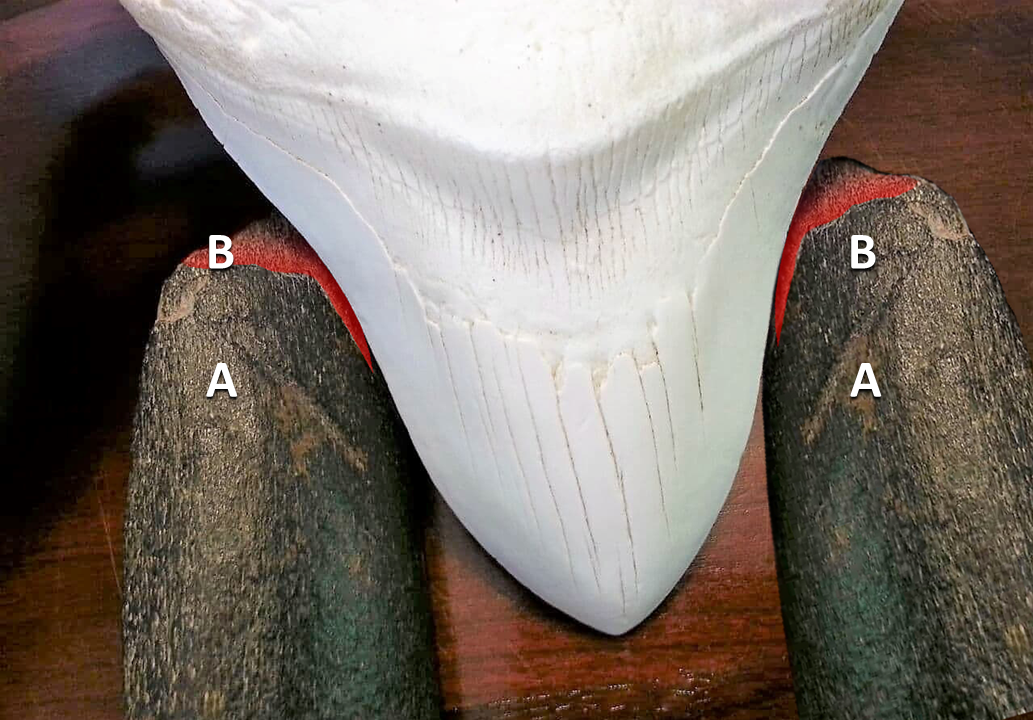
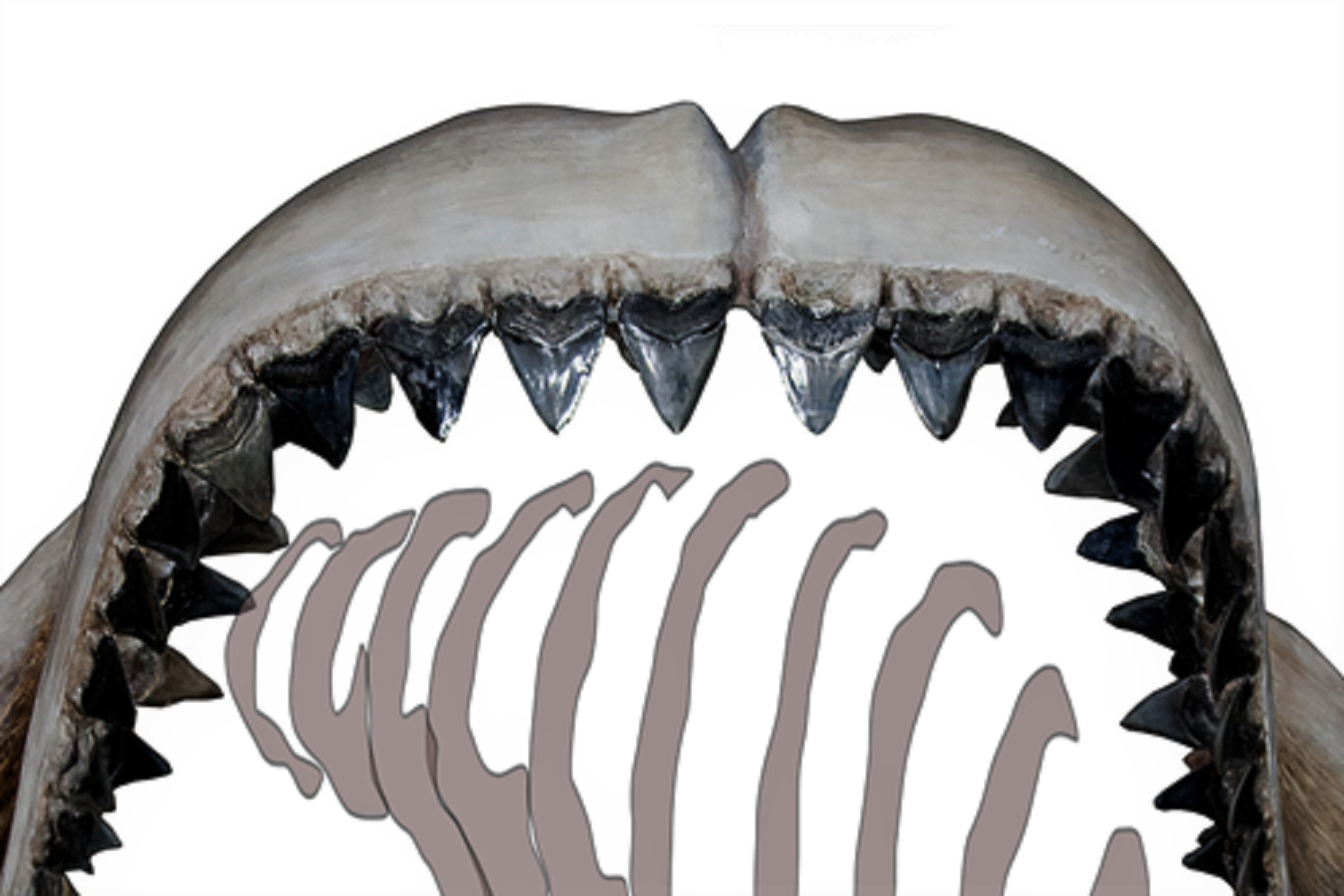
So, what did Megalodon eat? Were there even enough whale carcasses for the big sharks?
I’ve seen blog posts wholly dedicated to criticizing me and my Megalodon scavenger theory. Such posts, and their resultant discussions, tend to be laden with ad hominem attacks. This is the recourse of pseudo-intellectual keyboard warriors who have no evidence to back up their arguments. I know the shark is big business – the monstrous “star” of numerous books and movies, where it’s been hyped as this ultimate predator – but the science doesn’t support this. And that’s what we’re doing; we’re “following the science”. There’s no bias in our observations of a fish that died out 3.6mya. It’s just common sense and scientific conclusions based on overwhelming evidence. Jurassic Park 3 fans of Spinosaurus were outraged when evidence surfaced that indicated their invincible “T-rex killer” was, in fact, a semi-aquatic, fish-eating quadruped with a slender snout. Eventually, reality sank in. The same thing applies here.
I’d be reticent in my duties if I didn’t touch on one last bit of silliness that size-obsessed Megalodon fanboys love to shout to anyone who will listen: “Hawthorne doesn’t know what he’s talking about! There weren’t enough dead whales to feed all the sharks!” Sorry, Virginia, but that’s nonsense. There is a Santa Claus. And in this instance, his name is Max.
The fact is there were plenty of whale carcasses for the large, breeding adults, AKA brood stock, to eat. And I can prove it. I don’t have to crunch numbers about how many humpbacks and sperms we currently have, and how many would have died each year from assorted causes, hence we had all these dead whales littering the Miocene and Pliocene seas. All I have to do is use logic. Let’s use the great white for reference. How many white sharks exist is unknown. However, a 2014 report has estimated there are 3,000 individuals just in the Eastern North Pacific.* That suggests a fairly large population. However, in the interest of being conservative, I’m going to go with an estimated global population of 10,000 fish (hopefully, they don’t all end up in China as bowls of shark fin soup).
Now, of all those 10,000 fish, how many 20’+ individuals do we know of? One or two? 18-footers are also rare, and most of the adults seen range from 10-16 feet. Yet we know white sharks can hit twenty feet, and according to my book Monsters & Marine Mysteries, it’s confirmed they can top twenty-five. The same thing applied to Megalodon. Most fish are estimated at 34 feet (Wiki, Shimada 2019), yet we know from seven-inch teeth that they could reach fifty feet (Shimada 2019).
That said, scaled up, Megalodon relative sizes were probably similar. Most of the breeding adults were probably 35′ or more, and the larger fish, although uncommon/rare, were in the 40 or even 50-foot range. Of course, like the white shark, the numbers undoubtedly varied. For every 50-footer there was probably a dozen that stretched 45 feet, and scores that hit 40 feet. And there were probably hundreds of them in the upper thirties, if not thousands.
The point is, we know what Megalodon ate, and whether there were 10,000 of them (like today’s white shark) or 30,000 of them, all of those sharks needed whale meat. A lot of it. Slimmer, mid-sized (20-to-30-foot) Megalodons were undoubtedly still capable of hunting and killing the smallish baleen whales of their time, which were their size or smaller. As I’ve stated previously, it is an almost certainty that the younger Megalodons were active hunters. And each time one of them got hungry, it hunted and killed a small whale. It couldn’t consume the whole whale, of course, which was as big as it. So it left a carcass. A carcass that would be fed upon afterward by scavengers and create a scent trail of rotting flesh that would eventually attract – wait for it – adult Megalodons.
Thus, the population was self-sustaining. You had hundreds of younger “Megs” out there making kills, and the adults coming along and doing the cleanup work. It was a perfect food pyramid that worked for millions of years. But in the end, it must have contributed heavily to the big shark’s extinction. Once plankton stocks crashed, the small baleen whales that relied on them died off. The younger sharks had no food, or had to subsist on smaller prey items such as sea turtles, large fish, etc. A parallel would be extant Orcas consuming sea otters when there are no seals, or when salmon stocks crash. In the case of Megalodon, targeting smaller prey might have allowed the younger fish to survive for a time, but it left little or no carcasses for the adults. And the big adults with their specialized teeth, heavily dependent as they were on their progeny to feed them, had nothing to eat. They couldn’t hunt fish, and they couldn’t tackle the great whales that had emerged in place of the small baleen whales. No big sharks means no baby sharks. Ironically, the chink in Megalodon’s armor ended up being the very strengths that had allowed them to be successful for so long: their size and specialization.
And just like that, in the blink of an evolutionary eye, they were gone . . .
I hope you enjoyed my study on history’s largest predatory fish. To read my investigation into possible forty-foot sharks still prowling our oceans, check out Monsters & Marine Mysteries. And if you enjoy reading novels featuring extant Megalodons (and other monstrous marine predators) be sure to check out my Kronos Rising novel series.
Max Hawthorne
